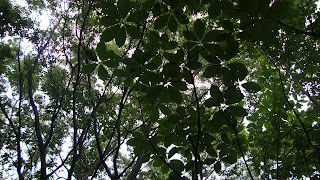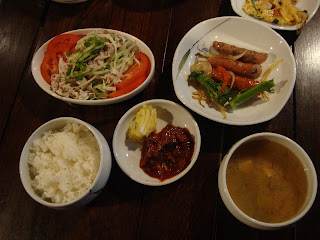Sato
Mieko-san is the kind of person anyone would be lucky to meet—energetic, high-spirited, knowledgeable, positive, and kind.
Yesterday we visited a quite genius handmade soba (buckwheat noodle) shop.
The wall decorations were made from Obi (the sash on a kimono). Sato-san explained that many women are handed down kimonos from their mothers and grandmothers that they don't use, so they find creative ways of keeping them around. This is really funny, because I don't see myself creating a wall decoration from my mother's hand-me-down clothes, but this really works out well!
I have to say that I am forever grateful about these tables: many Japanese restaurants, even today, have low tables where your legs die half-way through the meal from sitting on them. These tables are low, but there is a cavity under the table to rest your legs.
As Sato-san explained, it takes over 100 kneads the make these handmade noodles "adequately chewy." The side dishes were vegetable tempura, and pickled cucumbers (kyuri no tsukemono). After we finished the soba, they gave us something Sato-san called "soba juice" which I'm guessing was the water that remains after boiling the noodles—that is what the taste was like, anyway.
The women at the shop were curious about my origin and, after I presented myself, they gave me a handmade coin purse in the shape of a sandal as a thank-you gift for having visited their restaurant. This is one of the greatest things I have experienced in Japan: the ability of people to make you feel welcome, it is simply heart-warming.
After the soba, Sato-san wanted to go to Mount Shinobu-yama and on our way up we went by a shrine.
The small lady there, that's Sato-san!
You see those red posts? Well, Japanese people take their new cars in there. Then, the "shrine master" will bless the car and protect it for "Japanese people to have a safe trip."
I saw a "shrine master" from afar, and I had to take a picture of him, he's so cool!! ^_^
This is showing the animal whose year it is on the Chinese calendar this year being the year of the snake.
And, yeah, sorry for the poor camera skills >_<
Most Japanese people have a Shinto altar at their home. One of the key aspects of the altar is the kamidana, the home of the kami (god) that the altar is dedicated to.
After a Japanese person dies, the kamidana can't be thrown away as trash, so it is taken to a Shinto shrine to be re-blessed by a "shinto master."
Kamidanas
Many Japanese also keep Omamori (talismans) dedicated to a series of petitions such as good health, happiness, love, a safe trip... or some even have them personalized for purposes such as doing well on an exam or finding a good partner to marry.
Just like kamidanas these items are considered sacred and cannot be thrown away, so they are also taken to a shrine.
This is a Torii, it is a symbolical entrance to a shrine, marking sacred space.
We came across this sign exiting the shrine. It says "Do not park, God is watching" lol
After the awesomeness of the shrine, we went up Mount Shinobu-yama, and it was great!
Small shrine on the way up Shinobu-yama
A sight of Fukushima City
At night, after a long awesome day, Shimada-san prepared Miska and I some dinner. Miska is the other volunteer and he's from Finland. Shimada-san is another remarkable woman that I will definitely introduce on my next blog!
























No comments:
Post a Comment